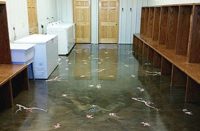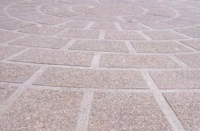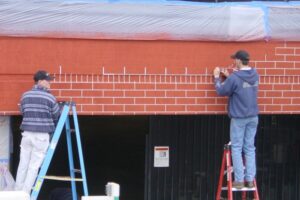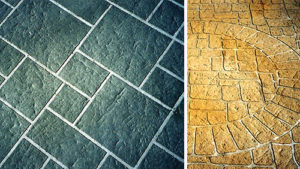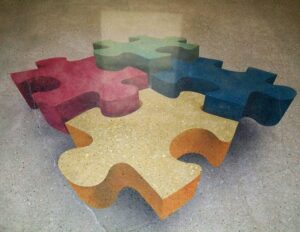A surface-preparation product called The Profiler from Surface Gel Tek can be used to create an etched effect with stencils. In these photos, Dane Hantz of Dane Concrete Design in Prescott, Arizona, demonstrates the technique. The surface was a steel-troweled concrete floor in a home. Hantz wanted to create a 60-linear-foot border around the room.
Hantz masked off the border area and applied a rustcolored acid stain. He then applied a self-adhesive 3-mil vinyl stencil to the floor. Surface Gel Tek or a shop that makes vinyl signs can cut stencils to order from your artwork, but you can cut small ones yourself out of 3-mil vinyl contact paper. The stencil was burnished onto the concrete surface with a plastic trowel.
With an acid-resistant brush, Hantz applied The Profiler to the open part of the stencil. The product is an acid gel that reacts with the cementitious material on the surface. The gel formulation minimizes the fumes generated, making it safe for indoor use with ventilation. It’s more pleasant to work with than plain old hydrochloric (muriatic) acid.
In this case, Hantz let the gel work for three minutes, and then scraped it off. Most users let it work for 5-15 minutes. Once the surface has reached the texture of 120-grit sandpaper, the gel has reacted completely with the cementitious material. Leaving it on longer won’t create a deeper etch, though it won’t do any harm. If you want a deeper etch, you must wash off the exhausted gel and apply a fresh coat.
When etching was done (the gel darkens slightly when the reaction is complete), Hantz scraped off the gel, diluted it with water, and discharged it to the sewer. He then flushed the cement surface with water, which also could be discharged to the sewer.
Hantz then removed the stencil and let the surface dry thoroughly before sealing it with a solvent-based acrylic sealer.
The Profiler prepares troweled concrete surfaces for painting or other finishing by giving them a slight tooth. The stenciled area can be left uncolored, as in this example, or colored with an acrylic stain. Acid stain is not necessary, as the necessary acid etch is provided by the gel.
